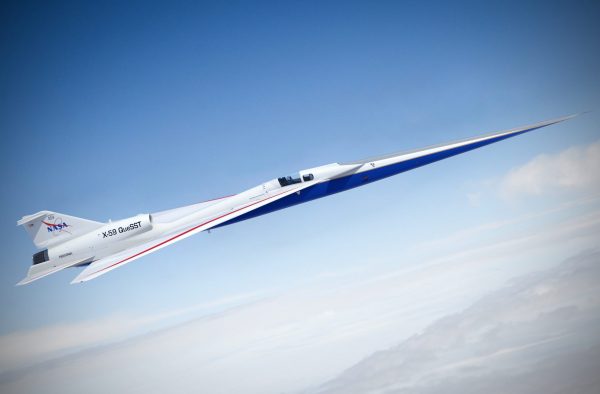The X-59 QueSST is an experimental aircraft that is being developed by Lockheed Martin for the US space agency NASA. The project, aimed at developing a quiet supersonic plane, has made major strides since its contract was handed over to Lockheed Martin in 2016.
Now, the final assembly for the plane is completed and it is ready to be shipped off for structural testing.
Supersonic flight in essence refers to flights that travel at speeds greater than the speed of sound. The first flight to have achieved this feat was NASA’s X-1 aircraft (‘X’ standing for experimental) — the first in line in the institution’s tradition of X-planes.

Currently, commercial planes are not allowed to fly at supersonic speeds over land. This is because in doing so, they would end up generating sonic booms, extremely loud and disruptive sound created by shock waves that are in turn made by objects traveling at supersonic speeds.
While the sonic boom is only heard briefly, in actuality, it is being produced continuously for as long as the aircraft remains supersonic.
The loud impact will be heard by different people at different times at varying points on the flight path depending on when the supersonic aircraft crosses the region. Owing to this, the US and multiple other countries imposed an almost complete ban on such flights over their territories.
Now, 75 years after the X-plane series was started, NASA-commissioned and Lockheed Martin-developed X-59 QueSST (Quiet SuperSonic Technology) is aiming to break the sound barrier a lot more quietly — by reducing the sonic boom to an acceptable level.

The objective is to design the aircraft in a manner that allows the shock waves it generates to be spaced roughly equally along its length. This would ensure that the shock waves don’t merge together into a double shock boom, rather become individually mellow and weakened.
Technological advancements in computer-aided design are the backbone of this effort.
It’s pertinent to mention that the first supersonic commercial airliner, Concorde — an Anglo-French venture, was retired in 2003 in the aftermath of the crash of Air France Flight 4590 in 2000 that killed all 100 passengers and nine crew members on board.
The British and French also cited rising maintenance costs and plunging demand as key concerns, The EurAsian Times reported earlier.
X-59 QueSST – How It Has Been Designed
The US aerospace giant Lockheed claims that the X-59’s structure would greatly lower the decibel level of a sonic boom reaching the ground. The plane will be flown as part of a mission whose aim is to collect data on quiet supersonic flight and gauge public reactions to supersonic “thumps”.
The success of this design could lead to the possibility of commercial supersonic flights that can drastically cut down on the time flights take to traverse distances.

The demonstrator model that the firm has created is a single-engine aircraft, that measures 28.7 meters lengthwise and has a 9-meter wingspan. The aircraft has an elongated nose designed to lower sound levels.
The EurAsian Times had previously reported that the experimental plane is powered by F414-GE-100 turbofan engines that are specially designed for installation on the X-59. They were supplied to NASA last year. The aircraft is expected to be compliant with International Civil Aviation Organisation (ICAO) standards by 2025. The project has seen delays due to the pandemic.
X-59 QueSST – Development Timeline
In February 2016, NASA awarded Skunk Works, a Lockheed Martin branch, a contract for a preliminary design of the X-59, worth $247.5 million. The target was to pre-design the plane by 2020 and deliver it by 2021. However, the onset of the COVID-19 pandemic had delayed the flight testing.
In April 2018, Skunk Works was selected for the design, build, and flight test of the X-59, and in November that year, the manufacturing of the first parts to be put on the X-59 began. In June 2019, the study results and concept for the quiet supersonic passenger airplane were revealed. In a major development in September that year, NASA and Skunk Works completed the critical design review for the X-59.
The team has continued to make significant progress on this experimental airplane’s assembly. In late October this year, the aircraft was pulled away from the jig support system. This system is similar to scaffolding and helps ensure that all of the aircraft’s hardware stays placed together correctly throughout the manufacturing process.
With the X-59 unrestrained by the jig, the plane will move on to the final assembly phase that includes the first “power-on” of the aircraft to take account of its internal systems.
Upon the completion of this phase, the X-59 will be sent off to Lockheed Martin’s facilities in Fort Worth, Texas. Here, the aircraft will undergo structural tests that remain to be conducted. The first flight of the X-59 is now planned for 2022.
- Written by Shreya Mundhra/EurAsian Times Desk
- Contact the author at: shreyya.mundhra@gmail.com
- Follow EurAsian Times on Google News




